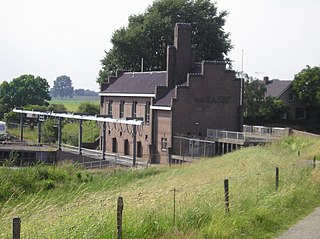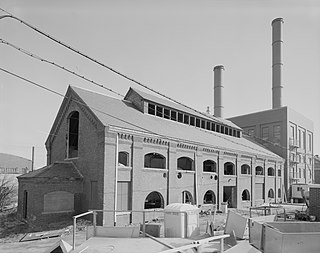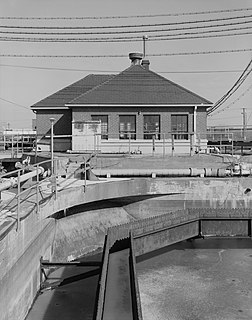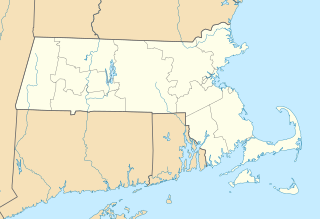
Cranston, once known as Pawtuxet, is a city in Providence County, Rhode Island, United States. The official population of the city is 80,559, making it the second largest in the state. The center of population of Rhode Island is located in Cranston. Cranston is a part of the Providence metropolitan area.

The Blackstone River is a river in the U.S. states of Massachusetts and Rhode Island. It flows approximately 48 mi (80 km) and drains a watershed of approximately 540 sq. mi (1,400 km2). Its long history of industrial use has left a legacy of pollution, and it was characterized by the United States Environmental Protection Agency in 1990 as "the most polluted river in the country with respect to toxic sediments."

The San Francisco Public Utilities Commission (SFPUC) is a public agency of the City and County of San Francisco that provides water, wastewater, and electric power services to the city and an additional 1.9 million customers within three San Francisco Bay Area counties.

Pumping stations, also called a pumphouse in situations such as drilled wells and drinking water, are facilities including pumps and equipment for pumping fluids from one place to another. They are used for a variety of infrastructure systems, such as the supply of water to canals, the drainage of low-lying land, and the removal of sewage to processing sites. A pumping station is, by definition, an integral part of a pumped-storage hydroelectricity installation.

The City of Toronto Water Division is a municipal division of the City of Toronto under Infrastructure and Development Services that is responsible for the water supply network, and stormwater and wastewater management in Toronto, Ontario, Canada, as well as parts of Peel and York Regions.

Sewage sludge treatment describes the processes used to manage and dispose of sewage sludge produced during sewage treatment. Sludge is mostly water with lesser amounts of solid material removed from liquid sewage. Primary sludge includes settleable solids removed during primary treatment in primary clarifiers. Secondary sludge separated in secondary clarifiers includes treated sewage sludge from secondary treatment bioreactors.
Dallas Water Utilities (DWU) is the water and wastewater service operated by the City of Dallas, Texas, in the United States. DWU is a non-profit City of Dallas department that provides services to the city and 31 nearby communities, employs approximately 1450 people, and consists of 26 programs. DWU's budget is completely funded through the rates charged for water and wastewater services provided to customers. Rates are based on the cost of providing the services. The department does not receive any tax revenues. Primary authority and rules for the department are listed in Chapter 49 of the Dallas City Code.

Elmwood is a neighborhood in the South Side of Providence, Rhode Island. The triangular region is demarcated by Broad Street, Elmwood Avenue, and Interstate 95.

The Chemical Building is a historic wastewater treatment building at Field's Point Wastewater Treatment Facility in Providence, Rhode Island. Built in 1900–01, it is one of the two oldest buildings at Providence's main sewage treatment facility. It is a 2-1/2 story brick structure measuring 103 feet (31 m) by 38 feet (12 m). The long facades are divided into 9 bays, separated by brick piers. When originally built, the structure had a concrete first floor, a wooden second floor, and a loft area accessed by catwalks, and was used to hold and deliver chemicals used to neutralize the wastewater arriving via the Ernest Street Sewage Pumping Station. In the 1930s the plant was converted to use an active sludge process, and the interior of the building was altered to be a single large chamber.

The Ernest Street Sewage Pumping Station is an historic wastewater pumping station at Ernest and Ellis Streets near the wastewater treatment facility at Field's Point in Providence, Rhode Island. The surviving elements of the station include a main pumphouse and a smaller screening house, both built in 1897-98 as part of a major effort to modernize Providence's sewage treatment facilities. A third structure, a boiler house, was demolished in 1987, and a tall smokestack was taken down in the 1930s. The main pumphouse is a tall single-story brick structure with a hip roof and Colonial Revival features, and is set near Ernest Street, a short way east of its junction with Allens Avenue. The screening house is a smaller square structure, also with a hip roof, set behind and to the right of the pumphouse. The facility is used to pump raw sewage through an 88-inch main to the treatment facility.

The Return Sludge Pumping Station, Fields Point Sewage Treatment Plant is an historic wastewater pumping station in the Field's Point Sewage Treatment Facility on Ernest Street in Providence, Rhode Island. It is a rectangular hip-roofed brick and concrete structure, located adjacent to the facility's aeration tanks, and is not readily visible from any public way. The building houses a number of large pumps in a large concrete substructure that is below grade. The facility was built in 1934–35, when the sewage treatment method was changed from a chemical process to a biological one, and is used to return biologically active sludge from the aeration tanks back into the treatment process. The pumps in the building are no longer original, having been replaced several times. The building is one of three to survive in the Field's Point area from the early decades of Providence's wastewater treatment system. the others are the Ernest Street Sewage Pumping Station and the Chemical Building; the Sludge Press House was demolished sometime in the last 30 years.

The Sludge Press House, was an historic wastewater treatment facility building at the Fields Point Sewage Treatment Plant at Fields Point, Rhode Island in Providence, Rhode Island. It was a two-story brick structure, located near the center of the Field's Point facility, just east of the Chemical Building. It was about 138 by 51 feet in size, with a hip roof, and was built 1899-1901 as part of Providence's first wastewater treatment system. It house the facilities used at the end of the treatment process by which remaining solids were dewatered and compressed before final disposal.

The Washington Park Sewage Pumping Station is an historic wastewater pumping facility in Providence, Rhode Island. Its principal visible component is a concrete block structure, finished in stucco and topped by a hip roof, which is about 16 by 16 feet. This building stands atop a large cast-in-place concrete well, in which pumps and gate valves are housed. The facility was built in 1911 to pump raw sewage from the low-lying Washington Park area to the Field's Point wastewater treatment facility, which lies about 1,000 feet (300 m) to the north. The pump station is located well back from the street, behind a low brick distribution facility. It was added to the National Register of Historic Places in 1989.

The Calf Pasture Pumping Station Complex is a historic sewage treatment facility at 435 Mount Vernon Street on Columbia Point in the Dorchester section of Boston, Massachusetts which was built in the 1880s.

Fields Point is a historic park in the Washington Park neighborhood of Providence, Rhode Island jutting into Narragansett Bay right near the Providence River and Route 95.

A chopper pump is a centrifugal pump which is equipped with a cutting system to facilitate chopping or maceration of solids that are present in the pumped liquid. The main advantage of this type of pump is that it prevents clogging of the pump itself and of the adjacent piping, as all the solids and stringy materials are macerated by the chopping system. Chopper pumps exist in various configurations, including submersible and dry-installed design and they are typically equipped with an electric motor to run the impeller and to provide torque for the chopping system. Due to its high solids handling capabilities, the chopper pump is often used for pumping sewage, sludge, manure slurries, and other liquids that contain large or tough solids.
Domenic Thomas Russillo, AIA (1902-1980), was a minor American architect who practiced in mid-20th-century Rhode Island and Massachusetts.

The Office of City Engineer of Providence, Rhode Island is an office that is credited with the design of a number of notable public works.

The Newtown Creek Wastewater Treatment Plant is the largest sewage treatment facility operated by the New York City Department of Environmental Protection. Since 2010, its eight metallic "digester eggs," which are 140 feet tall and dramatically illuminated with blue light at night, have made it a local landmark, particularly to motorists on several nearby roadways in the New York City boroughs of Brooklyn, Queens, and Manhattan. It is located on the Newtown Creek in Brooklyn's Greenpoint neighborhood along Greenpoint Avenue.
The Great Lakes Water Authority (GLWA) is a regional water authority in the U.S. state of Michigan. It provides drinking water and sewer services for the Southeast Michigan communities, including Wayne, Oakland, and Macomb counties, among others.



















